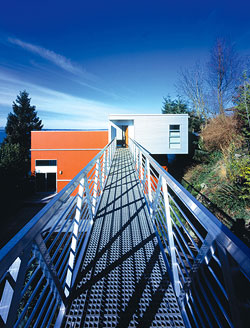Thanks, Rem. Or maybe we should be more grateful to city librarian Deborah Jacobs. Or hometown boy Steven Holl (designer of the Bellevue Arts Museum), now based in New York. Whatever the reason, Seattle is slowly starting to think outside the classic box house. This city of settled neighborhoods has long been a bastion of conservative architectural parochialism, of carefully tended Craftsman bungalows and proudly dowdy Tudor revival brick piles. Modernism gained a toehold with the midcentury modernist movement represented here by Roland Terry, Paul Thiry, and others, but on a residential scale, it too often translated into cheap, low-roofed ranch houses and sliding glass doors that didn’t keep the rain out. For this reason, perhaps, those trad-styled McMansions sprawling across the Eastside are erasing childhood memories of the rambler. In Seattle proper, preservation has always been more popular than innovation; God forbid we should upset the neighbors.
Now, however, those old conventions and biases are being reconsidered. Modernism no longer means modernism for its own pure design sake, but is being redefined as something more livable, comfortable, and family-friendly. We’ve found ways to create clean lines without being cold about it. New materials, including some prefabricated elements, can actually be cheaper, greener, and more efficient for those with limited lots, budgets, and time for home maintenance. At the same time, Seattle’s many newcomers are also bringing with them some different, bolder ideas about urban living—the willingness to stand out, take risks, and make a design statement. Let’s face it: Our famously polite, nonconfrontational Seattle style could benefit from a more outspoken aesthetic, especially when civic architecture, like the new Central Library, has opened up the conversation.
Here, we look at a modernist redo that causes barely a ripple in its established hood. We tour a nontraditional yard project that challenges traditional boundaries between inside and outside. And we profile one of Seattle’s most eccentric modernist designs, and designers, shrouded in mystery and darkness on the shady slope of Capitol Hill.
Eds.




